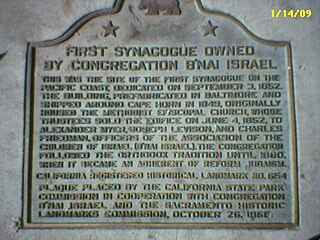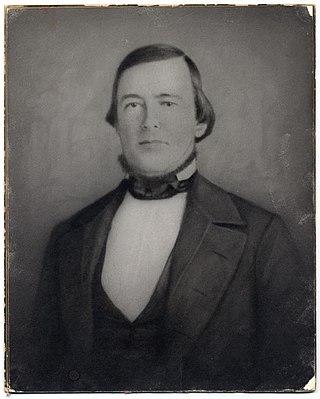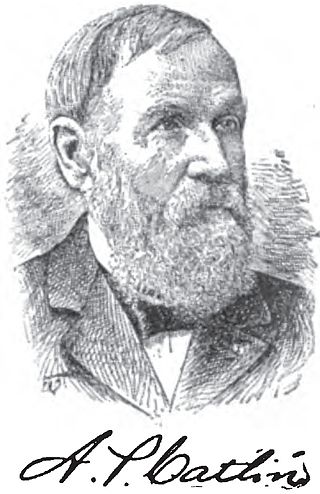
Sacramento is the capital city of the U.S. state of California and the seat of Sacramento County. Located at the confluence of the Sacramento and American Rivers in Northern California's Sacramento Valley, Sacramento's 2020 population of 524,943 makes it the fourth-most populous city in Northern California, sixth-most populous city in the state, and the ninth-most populous state capital in the United States. Sacramento is the seat of the California Legislature and the Governor of California.
The history of Sacramento, California, began with its founding by Samuel Brannan and John Augustus Sutter, Jr. in 1848 around an embarcadero that his father, John Sutter, Sr. constructed at the confluence of the American and Sacramento Rivers a few years prior.

The Capitol Mall or Capitol Mall Boulevard is a major street and landscaped parkway in the state capital city of Sacramento, California. Formerly known as M Street, it connects the city of West Sacramento in Yolo County to Downtown Sacramento. Capitol Mall begins at the eastern approach to the Tower Bridge, and runs east to Plaza de California and the California State Capitol.

Congregation B'nai Israel is a Reform Jewish congregation and synagogue, located at 3600 Riverside Boulevard, in Sacramento, California, in the United States. Founded in 1852 as an Orthodox community, the congregation is the oldest Jewish congregation in Sacramento. The congregation dates the California Gold Rush of 1849, when Jewish settlers gathered to observe the High Holy days. The congregation purchased its first building at 7th and L streets on September 2, 1852, making it the first synagogue west of the Mississippi River.

Hardin Bigelow was the first elected mayor of the city of Sacramento, California, which was known then as "Sacramento City." Bigelow's efforts to construct Sacramento's first levees won him enough support to become mayor in Sacramento's first mayoral elections in February 1850. Bigelow served seven months, from April to November, before succumbing to cholera; while he was mayor, Sacramento averted disaster in a potentially devastating flood, but fell victim to a series of April fires, a riot, and a cholera epidemic.

The Sacramento Historic City Cemetery, located at 1000 Broadway, at 10th Street, is the oldest existing cemetery in Sacramento, California. It was designed to resemble a Victorian garden and sections that are not located in level areas are surrounded by brick or concrete retaining walls to create level terraces. The cemetery grounds are noted for their roses which are said to be among the finest in California.

This article is a timeline of the history of the city of Cleveland, Ohio, USA.

Amos Parmalee Catlin was a California State Legislator and was instrumental in Sacramento becoming the capital of the State of California.
The following is a timeline of the history of the city of Hartford, Connecticut, USA.
The following is a timeline of the history of the city of Des Moines, Iowa, US.
The following is a timeline of the history of the city of Memphis, Tennessee, US.
The following is a timeline of the history of the city of San Francisco, California, United States.
The following is a timeline of the history of the city of Austin, Texas, USA.
The following is a timeline of the history of the city of Columbus, Ohio, United States.
The following is a timeline of the history of the U.S. city of Detroit, Michigan.
The following is a timeline of the history of Washington, D.C., the capital city of the United States.
The following is a timeline of the history of the city of Tallahassee, Florida, U.S.
Chevra Kaddisha Cemetery, later known as Home of Peace Cemetery, was the first Jewish cemetery in California founded on November 12, 1850, by the Sacramento City Hebrew Association, and was once located at 33rd at K Streets in the East Sacramento neighborhood of Sacramento, California. The cemetery closed around 1924, and is no longer standing. It is the location of a strip mall, there is no historical plaque.
New Helvetia Cemetery, initially named Sutter Fort Burying Ground, is a defunct cemetery founded in c. 1845 and closed in 1912, formerly located at the northeast corner of Alhambra Boulevard and J Street in the East Sacramento neighborhood of Sacramento, California. It was the first cemetery in the city of Sacramento.
The Home of Peace Cemetery is a Jewish cemetery founded in 1924, and located at 6200 Stockton Boulevard in Sacramento, California. This cemetery contains some of the earliest Jewish gravestones in the western United States, moved from Chevra Kaddisha Cemetery.









